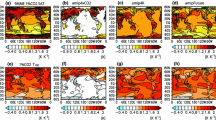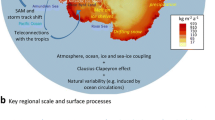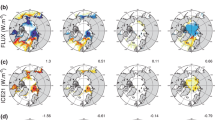Abstract
The role of reduced atmospheric CO2 concentration and ice sheet topography plus its associated land albedo on the LGM climate is investigated using a coupled atmosphere-ocean-sea ice climate system model. The surface cooling induced by the reduced CO2 concentration is larger than that by the ice sheet topography plus other factors by about 30% for the surface air temperature and by about 100% for the sea surface temperature. A large inter-hemispheric asymmetry in surface cooling with a larger cooling in the Northern Hemisphere is found for both cases. This asymmetric inter-hemispheric temperature response is consistent in the ice sheet topography case with earlier studies using an atmospheric model coupled with a mixed-layer ocean representation, but contrasts with these results in the reduced CO2 case. The incorporation of ocean dynamics presumably leads to a larger snow and sea ice feedback as a result of the reduction in northward ocean heat transport, mainly as a consequence of the decrease in the North Atlantic overturning circulation by the substantial freshening of the North Atlantic convection regions. A reversed case is found in the Southern Ocean. Overall, the reduction in atmospheric CO2 concentration accounts for about 60% of the total LGM climate change.








Similar content being viewed by others
References
Barnola JM, Raynaud D, Korotkevich YS, Lorius C (1987) Vostok ice core provides 160 000-year record of atmospheric CO2. Nature 329: 408–418
Boer GJ (1993) Climate change and the regulation of the surface moisture and energy budget. Clim Dyn 8: 225–239
Boer GJ, Yu B (2003) Climate sensitivity and response. Clim Dyn 20: 415–429
Boer GJ, McFarlane NA, Lazare M (1992) Greenhouse gas-induced climate change simulated with the CCC second-generation general circulation model. J Clim 5: 1045–1077
Boer GJ, Flato GM, Ramsden D (2000) A transient climate change simulation with greenhouse gas and aerosol forcing: projected climate to the twenty-first century. Clim Dyn 16: 427–450
Boyle EA, Keigwin L (1987) North Atlantic thermohaline circulation during the past 20 000 years linked to high-latitude surface temperature. Nature 330: 35–40
Broccoli AJ (2000) Tropical cooling at the Last Glacial Maximum: an atmosphere-mixed layer ocean model simulation. J Clim 13: 951–976
Broccoli AJ, Manabe S (1987) The influence of continental ice, atmospheric CO2, and land albedo on the climate of the last glacial maximum. Clim Dyn 1: 87–99
Broecker WS, Henderson GM (1998) The sequence of events surrounding Termination II and their implications for the cause of glacial-interglacial CO2 changes. Paleoceanogr 13: 352–364
CLIMAP (1976) The surface of the Ice-Age Earth. Science 191: 1131–1136
CLIMAP (1981) Seasonal reconstructions of the Earth’s surface at the last glacial maximum. Geol Soc Am Map Chart Ser, MC-36
Crowley TJ, Baum SK (1997) Effect of vegetation on an ice-age climate model simulation. J Geophys Res 102: 16463–16480
Fairbanks RG (1989) A 17000-year glacio-eustatic sea level record: influence of glacial melting rates on the Younger Dryas event and deep-ocean circulation. Nature 342: 637–642
Fichefet T, Hovine A, Dupplessy J-C (1994) A model study of the Atlantic thermohaline circulation during the last glacial maximum. Nature 372: 252–255
Flato GM, Hibler III WD (1992) Modelling pack ice as a cavitating fluid. J Phys Oceanogr 22: 626–651
Flato GM, Boer GJ (2001) Warming asymmetry in climate change simulations. Geophys Res Lett 28: 195–198
Flato GM, Boer GJ, Lee WG, McFarlane NA, Ramsden D, Reader MC, Weaver AJ (2000) The Canadian Centre Climate Modelling and Analysis global coupled model and its climate. Clim Dyn 16: 451–467
Ganachaud A, Wunsch C (2000) Improved estimates of global ocean circulation, heat transport and mixing from hydrographic data. Nature 408: 453–457
Ganopolski A, Rahmstorf S, Petoukhov V, Claussen M (1998) Simulation of modern and glacial climates with a coupled global model of intermediate complexity. Nature 391: 351–356
Gent PR, McWilliams JC (1990) Isopycnal mixing in ocean circulation models. J Phys Ocenaogr 20: 150–155
Genthon C, Barnola JM, Raynaud D, Lorius C, Jouzel J, Barkov NI, Korotkevich YS, Kotlyakov VM (1987) Vostik ice core: climatic response to CO2 and orbital forcing changes over the last climatic cycle. Nature 329: 414–418
Hansen J, Lacis A, Rind D, Russell G, Stone P, Fung I, Ruedy R, Lerner J (1984) Climate sensitivity: analysis of feedback mechanisms. In: Hansen J, Takahashi T (eds) Climate processes and climate sensitivity. Geophys Mono 29, Am Geophys Union, Washington, DC, 130–163
Hansen J, Lacis A, Ruedy R, Sato M, Wilson H (1993) How sensitive is the world’s climate? Nat Geogr Res Explor 9: 143–158
Hansen J, Sato M, Ruedy R (1997) Radiative forcing and climate response. J Geophys Res 102: 6831–6864
Hays JD, Imbrie J, Shackleton NJ (1976) Variations in the Earth’s orbit: pacemaker of the ice ages. Science 194: 1121–1132
Haywood JM, Stouffer RJ, Wetherald RT, Manabe S, Ramaswamy V (1997) Transient response of a coupled model to estimated changes in greenhouse gas and sulfate concentrations. Geophys Res Lett 24: 1335–1338
Hewitt CD, Mitchell JF (1997) Radiative forcing and response of a GCM to ice age boundary conditions: cloud feedback and climate sensitivity. Clim Dyn 13: 821–834
Hewitt CD, Broccoli AJ, Mitchell JF, Stouffer RJ (2001) A coupled model study of the last glacial maximum: was part of the North Atlantic relatively warm? Geophys Res Lett 28: 1571–1574
Hewitt CD, Stouffer RJ, Broccoli AJ, Mitchell JF, Valdes PJ (2003) The effect of ocean dynamics in a coupled GCM simulation of the Last Glacial Maximum. Clim Dyn 20: 203–218
Hoffert MI, Covey C (1992) Deriving global climate sensitivity from paleoclimate reconstructions. Nature 360: 573–576
Imbrie J, Hays JD, Martinson DG, McIntyre A, Mix AC, Morley JJ, Pisias NG, Prell WL, Shackleton NJ (1984) The orbital theory of Pleistocene climate: Support from a revised chronology of the marine 18O record. In: Berger AL et al. (eds) Milankovitch and Climate, Part 1. Dordrecht, Netherlands, pp 269–305
Jouzel J, Lorius C, Petit JR, Genthon C, Barkov NI, Kotlyakov VM, Petrov VM (1987) Vostok ice cores: a continuous isotope temperature record over the last climatic cycle (160 000 years). Nature 329: 403–408
Kim S-J, Flato GM, Boer GJ, McFarlane NA (2002) A coupled climate model simulation of the Last Glacial Maximum, Part 1: transient multi-decadal response. Clim Dyn 19: 515–537
Kim S-J, Flato GM, Boer GJ, McFarlane NA (2003) A coupled climate model simulation of the Last Glacial Maximum, Part 2: approach to equilibrium. Clim Dyn 20: 635–661
Kitoh A, Murakami S, Koide H (2001) A simulation of the Last Glacial Maximum with a coupled atmosphere-ocean GCM. Geophys Res Lett 28: 2221–2224
Manabe S, Broccoli AJ (1985) The influence of continental ice sheets on the climate of an ice age. J Geophys Res 90: 2167–2190
Manabe S, Stouffer RJ, Spelman MJ, Bryan K (1991) Transient responses of a coupled ocean-atmosphere model to gradual changes of atmospheric CO2. Part I: annual mean response. J Clim 4: 785–818
Macdonald AM, Wunsch C (1996) An estimate of global ocean circulation and heat fluxes. Nature 382: 436–439
McFarlane NA, Boer GJ, Blanchet J-P, Lazare M (1992) The Canadian Climate Centre second-generation general circulation model and its equilibrium climate. J Clim 5(10): 1013–1044
Milankovitch M (1941) Canon of insolation and the ice age problem. K Ser Aka, Beograd (English translation by the Israel Program for the Scientific Translation). Special Publ 132, US Department of Commerce and Natl Sci Fdn, Washington, DC, USA
Neftel A, Oeschger H, Schwander J, Zumbrunn R (1982) Ice core sample measurements give atmospheric CO2 content during the past 40,000 years. Nature 295: 200–223
Peltier WR (1994) Ice age paleotopography. Science 265: 195–201
Ramaswamy V, Chen C-T (1997) Linear additivity of climate response co combined albedo and greenhouse perturbations. Geophys Res Lett 24: 567–570
Rutberg RL, Hemming SR, Goldstein SL (2000) Reduced North Atlantic deep water flux to the glacial Southern Ocean inferred from neodymium isotope ratios. Nature 405: 935–938
Semtner AJ (1976) A model for thermodynamic growth of sea ice in numerical investigations of climate. J Phys Oceanogr 6: 379–389
Shin S-I, Liu Z, Otto-Bliesner B, Brady E, Kutzbach J, Harrison S (2003) A simulation of the Last Glacial Maximum climate using the NCAR-CCSM. Clim Dyn 20: 127–151
Stouffer RJ, Manabe S (1999) Response of a coupled ocean-atmosphere model to increasing atmospheric carbon dioxide: Sensitivity to the rate of increase. J Clim 12: 2224–2237
Voss R, Sausen R (1996) Techniques for asynchronous and periodically-synchronous coupling of atmosphere and ocean models, Part II: impact of variability. Clim Dyn 12: 605–614
Weaver AJ, Eby M, Fanning AF, Wiebe EC (1998) Simulated influence of carbon dioxide, oribital forcing and ice sheets on the climate of the last glacial maximum. Nature 394: 847–853
Wyputta U, McAvaney BJ (2001) Influence of vegetation changes during the Last Glacial Maximum using the BMRC atmospheric general circulation model. Clim Dyn 17: 923–932
Acknowledgements
The simulations discussed in this study were made while the author was at the Canadian Centre for Climate modelling and analysis (CCCma) and this study greatly benefited from the consistent support and helpful comments by George Boer and Greg Flato. The author also wishes to thank other CCCma colleagues, especially Bernard Miville, Warren Lee, Daniel Robitaille, and Fouad Majaess for model and technical support. Valuable comments from colleagues at Duke University, especially Thomas Crowley, William Hyde, and Jesse Kenyon are appreciated. The author would like to thank to Anthony Broccoli and anonymous reviewer for their constructive reviews. This study was supported by the Climate System History and Dynamics (CSHD) program and Canadian Climate Research Network, Climate Variability Project.
Author information
Authors and Affiliations
Corresponding author
Rights and permissions
About this article
Cite this article
Kim, S. The effect of atmospheric CO2 and ice sheet topography on LGM climate. Climate Dynamics 22, 639–651 (2004). https://doi.org/10.1007/s00382-004-0412-2
Received:
Accepted:
Published:
Issue Date:
DOI: https://doi.org/10.1007/s00382-004-0412-2




